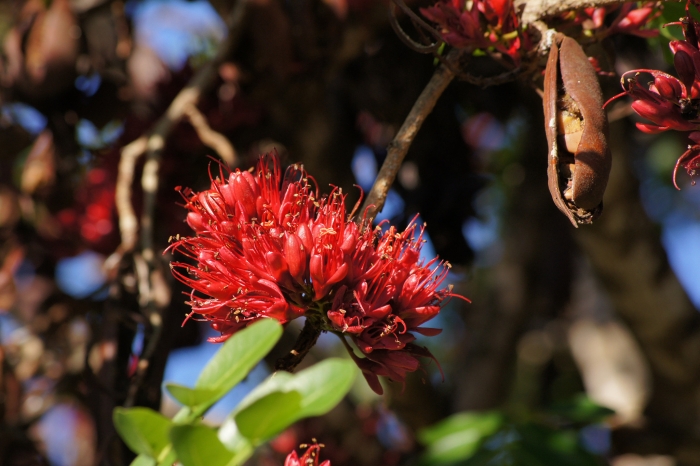Weeping Boer-Bean
(Schotia brachypetala)
Weeping Boer-Bean (Schotia brachypetala)
/
/

Tatters
CC BY-SA 2.0
Image By:
Tatters
Recorded By:
Copyright:
CC BY-SA 2.0
Copyright Notice:
Photo by: Tatters | License Type: CC BY-SA 2.0 | License URL: https://creativecommons.org/licenses/by-sa/2.0/ | Uploader: Tatters | Publisher: Flickr |


























Estimated Native Range
Summary
Schotia brachypetala, commonly known as Weeping Boer-bean, is a deciduous leguminous flowering tree native to the woodland and forest edges of Southern Africa. It typically reaches a height of 5 to 20 meters with a canopy spread of 5 to 15 meters, depending on growing conditions. The Weeping Boer-bean is characterized by its dense, spreading canopy and dark brown, deeply furrowed bark. Its flowers, which appear in spring, are a deep red color, rich in nectar, and highly attractive to birds and insects, creating a spectacular display. The tree also produces woody, brown pods that are slightly curved.
The Weeping Boer-bean is valued for its ornamental features, including its showy flowers and the shade it provides. It is widely cultivated in gardens and parks in warmer regions, where it serves as a shade tree or an ornamental specimen. This tree is relatively easy to maintain, requiring medium amounts of water and thriving in full sun to part shade. It prefers well-drained soils and is tolerant of drought once established. While it is generally pest-free, it can occasionally suffer from root rot if overwatered. The Weeping Boer-bean is not known for aggressive roots or significant disease problems, making it a suitable choice for urban planting. However, it is important to note that the tree’s size makes it more appropriate for larger landscapes.CC BY-SA 4.0
The Weeping Boer-bean is valued for its ornamental features, including its showy flowers and the shade it provides. It is widely cultivated in gardens and parks in warmer regions, where it serves as a shade tree or an ornamental specimen. This tree is relatively easy to maintain, requiring medium amounts of water and thriving in full sun to part shade. It prefers well-drained soils and is tolerant of drought once established. While it is generally pest-free, it can occasionally suffer from root rot if overwatered. The Weeping Boer-bean is not known for aggressive roots or significant disease problems, making it a suitable choice for urban planting. However, it is important to note that the tree’s size makes it more appropriate for larger landscapes.CC BY-SA 4.0
Plant Description
- Plant Type: Tree
- Height: 33-48 feet
- Width: 30-45 feet
- Growth Rate: Moderate
- Flower Color: Red
- Flowering Season: Summer, Fall
- Leaf Retention: Evergreen
Growth Requirements
- Sun: Full Sun, Part Shade
- Water: Medium
- Drainage: Fast
Common Uses
Bird Garden, Butterfly Garden, Edible*Disclaimer: Easyscape's listed plant edibility is for informational use. Always verify the safety and proper identification of any plant before consumption., Low Maintenance, Showy Flowers
Natural Habitat
Woodland and forest edges of Southern Africa
Other Names
Common Names: Tree-Fuchsia, Fuchsia-Tree
Scientific Names: , Schotia brachypetala, Schotia rogersii, Guillandinodes brachypetalum, Schotia brachypetala var. pubescens, Schotia latifolia, Schotia semireducta,
GBIF Accepted Name: Schotia brachypetala Sond.